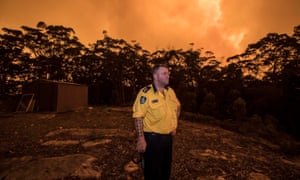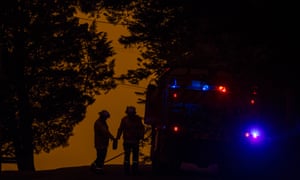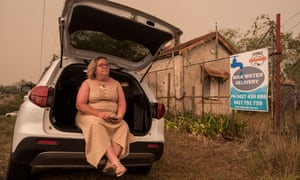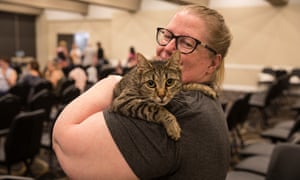The Gospers Mountain fire has consumed hundreds of thousands of hectares of forest and is now threatening towns and lives
The fire is two kilometres away, but the heat is already beginning to warm the faces of those who wait.
The air is eerily still. There is no wind. There are no birds. There is no natural noise, just the distant chatter of helicopters in the sky, flying between water source and flames.
“When you’re still, that’s when you worry,” says Greg Hodges, a volunteer firefighter and the strike team leader. “It’s the calm before the storm.”
Hodges is standing on the side of a road near half a dozen trucks on the outskirts of Kurrajong Heights, a small town surrounded by dramatic bushland which sweeps off the lower Blue Mountains and down on to the fringes of greater Sydney.

The air is eerily still. There is no wind. There are no birds. There is no natural noise, just the distant chatter of helicopters in the sky, flying between water source and flames.
“When you’re still, that’s when you worry,” says Greg Hodges, a volunteer firefighter and the strike team leader. “It’s the calm before the storm.”
Hodges is standing on the side of a road near half a dozen trucks on the outskirts of Kurrajong Heights, a small town surrounded by dramatic bushland which sweeps off the lower Blue Mountains and down on to the fringes of greater Sydney.

“So if it’s quiet and still, that’s when the worry is.”
It has thrown fire at thousands of people and communities, and now covers so many different regions of New South Wales that there are mountain residents, river people, and central coasters all battling the same beast.
Elsewhere in NSW and Victoria other fires have been just a fierce, some even making their own storms – a terrifying and uncontrollable effect of nature. But none are on the scale of Gospers.
Ashleigh Coskerie and Jonathon Evripidou live just down a small hill from where Hodges and his crew have assembled.
They and their neighbour Andrew Helwig have stayed to fight off ember attacks and spot fires on their houses.
“It’s looking pretty bad,” Evripidou says. “If it comes through it’s going to get 10 times worse, I know that.”
“It’s just a waiting game,” says Helwig.
Coskerie says they had heard their street name over the scanner radio and had a moment of panic, but that they feel better with so many fire crews outside. “We feel safer now we’ve got all the guys in the street … They’re right there if ... you know.”
Soon after, however, the crews pack up and the trucks drive out without a word. Orders have come through to move as the fire’s path has shifted.

If the sun had been visible through the smoke it would have been close to setting when the wind change roars through and sends the fire away from Hodges and his crew.
Kurrajong Heights is safe for now, but the change in direction is merely a change in destination for the destruction. Hodges packs up and they race towards the nearby town of Bilpin.
At the bowling club the Guardian is turned around. A neon sign blinks bright red and blue against the ferociously dark sky as trucks rush to set up defence lines at properties deep in the bush across the road.

The fire “took a bit of a run” he says with some understatement. Crews have run themselves ragged across the state as catastrophic conditions are followed by strong winds.
“The biggest impact was Dargsn and Bell … and also quite active just south of Bilpin as you’re aware,” he says.
A lot of people in the crowd are from Bilpin. People have been fleeing all day, some leaving behind pets, some leaving behind family adamant they would be able to defend their homes.
The pictures from media inside the containment zone come through at intervals and none are good. The meeting is tense.
“Will horse transport trucks be allowed through?” asks a woman with horses left behind on Bells Line of Road.
“Why aren’t the water trucks allowed up there?” asks another woman from Mount Bowen.
“That’s the first I’ve heard of it,” says Garlick.
“Are you thinking of bulldozing instead of backburning, considering what happened Monday?” The crowd bristles. Some of the fire around here started with a backburn.
Garlick stays calm.
“We’re confident this time that it won’t happen, because we’ve got at least seven days of lower temperatures and higher humidity coming, which is more conducive to backburning,” he says.
People are tired, stressed and confused – and they want to go home.
There has been a lot of conflicting information between the RFS, the police, the Live Traffic App, and the evening news, through no one’s fault. How do you streamline so many organisations in so many places fighting so many fires that just will not do what they’re supposed to?
Residents know this, but they’re scared.

“By heeding the warnings and leaving – made the job a lot easier for us and safer for you,” Garlick replies.
The meeting ends and Bilpin residents stay for an extra discussion about where to sleep. They’re not going home tonight, and instead will find somewhere else to stay. If they can’t, the club is open 24/7. Not strictly an evacuation centre, the large community club has opened its doors, sheltering, feeding and comforting people all day. Everyone and their pets have been welcomed.
No comments:
Post a Comment